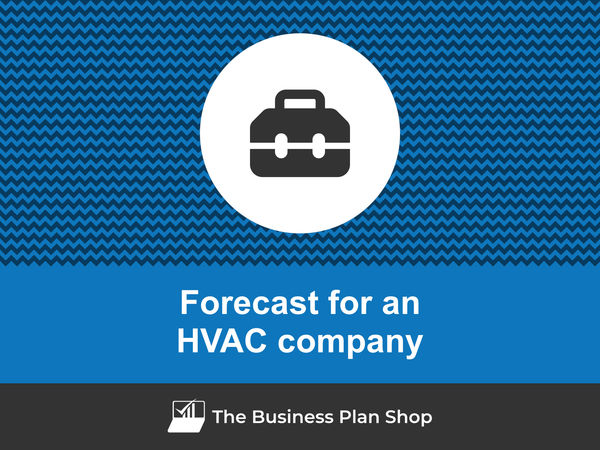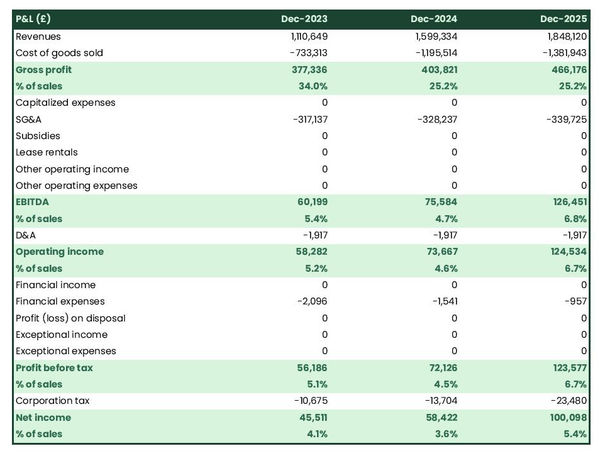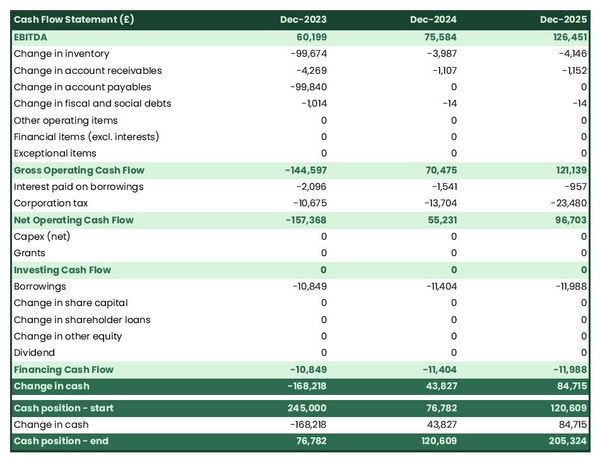How to create a financial forecast for an HVAC company?

Creating a financial forecast for your HVAC company, and ensuring it stays up to date, is the only way to maintain visibility on future cash flows.
This might sound complex, but with the right guidance and tools, creating an accurate financial forecast for your HVAC company is not that hard.
In this guide, we'll cover everything from the main goal of a financial projection, the data you need as input, to the tables that compose it, and the tools that can help you build a forecast efficiently.
Without further ado, let us begin!
Why create and maintain a financial forecast for an HVAC company?
Creating and maintaining an up-to-date financial forecast is the only way to steer the development of your HVAC company and ensure that it can be financially viable in the years to come.
A financial plan for an HVAC company enables you to look at your business in detail - from income to operating costs and investments - to evaluate its expected profitability and future cash flows.
This gives you the visibility needed to plan future investments and expansion with confidence.
And, when your trading environment gets tougher, having an up to date HVAC company forecast enables you to detect potential upcoming financing shortfalls in advance, enabling you to make adjustments or secure financing before you run out of cash.
It’s also important to remember that your HVAC company's financial forecast will be essential when looking for financing. You can be 100% certain that banks and investors will ask to see your numbers, so make sure they’re set out accurately and attractively.
Need a solid financial forecast?
The Business Plan Shop does the maths for you. Simply enter your revenues, costs and investments. Click save and our online tool builds a three-way forecast for you instantly.

What information is used as input to build an HVAC company financial forecast?
A HVAC company's financial forecast needs to be built on the right foundation: your assumptions.
The data required to create your assumptions will depend on whether you are a new or existing HVAC company.
If you are creating (or updating) the forecast of an existing HVAC company, then your main inputs will be historical accounting data and operating metrics, and your team’s view on what to expect for the next three to five years.
If you are building financial projections for a new HVAC company startup, you will need to rely on market research to form your go-to-market strategy and derive your sales forecast.
For a new venture, you will also need an itemised list of resources needed for the HVAC company to operate, along with a list of equipment required to launch the venture (more on that below).
Now that you understand what is needed, let’s have a look at what elements will make up your HVAC company's financial forecast.
The sales forecast for an HVAC company
From experience, it is usually best to start creating your HVAC company financial forecast by your sales forecast.
To create an accurate sales forecast for your HVAC company, you will have to rely on the data collected in your market research, or if you're running an existing HVAC company, the historical data of the business, to estimate two key variables:
- The average price
- The number of monthly transactions
To get there, you will need to consider the following factors:
- The average price of HVAC services may be affected by changes in material costs, such as the price of refrigerant or metal for ductwork.
- Extreme weather conditions, such as heat waves or harsh winters, can greatly impact the number of monthly transactions for HVAC services as customers may need urgent repairs or replacements.
- The state of the economy can also affect the business's average price, as customers may be more price-conscious during times of financial uncertainty.
- Changes in government regulations and energy efficiency standards can influence the types of products and services offered by the HVAC company, potentially affecting the average price and number of transactions.
- The overall demand for HVAC services in the local market can also play a role in the company's sales forecast. For example, a growing population or an increase in new construction projects can lead to higher demand and potentially higher prices.
Once you have an idea of what your future sales will look like, it will be time to work on your overhead budget. Let’s see what this entails.
Need inspiration for your business plan?
The Business Plan Shop has dozens of business plan templates that you can use to get a clear idea of what a complete business plan looks like.

The operating expenses for an HVAC company
Once you know what level of sales you can expect, you can start budgeting the expenses required to operate your HVAC company on a daily basis.
Expenses normally vary based on how much revenue you anticipate (which is why, from experience, it is always better to start your forecast with the topline projection), and where your business is based.
Operating expenses for an HVAC company will include some of the following items:
- Your staff costs, including salaries, benefits, and payroll taxes.
- Accountancy fees for maintaining financial records and preparing tax returns.
- Insurance costs for liability, property, and workers' compensation.
- Software licenses for HVAC-specific programs and tools.
- Banking fees for maintaining business accounts and processing transactions.
- Fuel and vehicle costs for company vehicles used for installations and service calls.
- Inventory and supply costs for purchasing and stocking necessary parts and equipment.
- Rent or lease payments for office and warehouse space.
- Advertising and marketing expenses to promote your services to potential customers.
- Training and certification costs for staff to stay updated on industry standards and techniques.
- Utilities, such as electricity and water, for running your office and warehouse.
- Vehicle maintenance and repair costs for company vehicles.
- Permits and licensing fees for operating your HVAC business.
- Office supplies and equipment, such as computers, phones, and furniture.
- Professional development and continuing education costs for yourself and your staff.
This list will need to be tailored to the specificities of your HVAC company, but should offer a good starting point for your budget.
What investments are needed to start or grow an HVAC company?
Creating and expanding an HVAC company also requires investments which you need to factor into your financial forecast.
Capital expenditures and initial working capital items for an HVAC company could include elements such as:
- HVAC Equipment: This includes items such as furnaces, air conditioners, heat pumps, and other heating and cooling units. These are essential for an HVAC company to provide services to clients.
- Service Vehicles: HVAC companies often require service vehicles to transport equipment and technicians to job sites. These can include vans, trucks, and other types of vehicles.
- Tools and Supplies: HVAC technicians require various tools and supplies to perform their job, such as wrenches, gauges, and refrigerant. These items need to be regularly replaced or upgraded to ensure efficient and effective service.
- Office Equipment: This includes items such as computers, printers, and other office supplies that are necessary for managing administrative tasks and keeping track of finances.
- Warehouse and Storage Facilities: HVAC companies often need warehouse and storage facilities to store equipment and supplies. This can include rental fees, insurance, and maintenance costs.
Again, this list is not exhaustive and will need to be adjusted according to the circumstances of your HVAC company.
Need a convincing business plan?
The Business Plan Shop makes it easy to create a financial forecast to assess the potential profitability of your projects, and write a business plan that’ll wow investors.

The financing plan of your HVAC company
The next step in the creation of your financial forecast for your HVAC company is to think about how you might finance your business.
You will have to assess how much capital will come from shareholders (equity) and how much can be secured through banks.
Bank loans will have to be modelled so that you can separate the interest expenses from the repayments of principal, and include all this data in your forecast.
Issuing share capital and obtaining a bank loan are two of the most common ways that entrepreneurs finance their businesses.
What tables compose the financial plan for an HVAC company?
Now let's have a look at the main output tables of your HVAC company's financial forecast.
The profit & loss forecast
The forecasted profit & loss statement will enable you to visualise your HVAC company's expected growth and profitability over the next three to five years.

A financially viable P&L statement for an HVAC company should normally show:
- Sales growing above inflation
- Stable or expanding (ideally) profit margins
- A net profit
This will of course depend on the stage of your business: a new venture might be loss-making until it reaches its breakeven point in year 2 or 3, for example.
The projected balance sheet
Your HVAC company's projected balance sheet provides a snapshot of your business’s financial position at year-end.
It is composed of three types of elements: assets, liabilities and equity:
- Assets: represent what the business possesses including cash, equipment, and accounts receivable (money owed by clients).
- Liabilities: represent funds advanced to the business by lenders and other creditors. They include accounts payable (money owed to suppliers), taxes payable and loans from banks and financial institutions.
- Equity: is the combination of what has been invested by the business owners and the cumulative profits and losses generated by the business to date (which are called retained earnings). Equity is a proxy for the value of the owner's stake in the business.

The projected cash flow statement
A projected cash flow statement for an HVAC company is used to show how much cash the business is generating or consuming.

The cash flow forecast is usually organised by nature to show three key metrics:
- The operating cash flow: do the core business activities generate or consume cash?
- The investing cash flow: how much is the business investing in long-term assets (this is usually compared to the level of fixed assets on the balance sheet to assess whether the business is regularly maintaining and renewing its equipment)?
- The financing cash flow: is the business raising new financing or repaying financiers (debt repayment, dividends)?
Cash is king and keeping an eye on future cash flows is imperative for running a successful business. Therefore, you should pay close attention to your HVAC company's cash flow forecast.
If you are trying to secure financing, note that it is customary to provide both yearly and monthly cash flow forecasts in a financial plan - so that the reader can analyze seasonal variation and ensure the HVAC company is appropriately capitalised.
Need a solid financial forecast?
The Business Plan Shop does the maths for you. Simply enter your revenues, costs and investments. Click save and our online tool builds a three-way forecast for you instantly.

Which tool should you use to create your HVAC company's financial forecast?
Using the right tool or solution will make the creation of your HVAC company's financial forecast much easier than it sounds. Let’s explore the main options.
Using online financial forecasting software to build your HVAC company's projections
The modern and easiest way is to use professional online financial forecasting software such as the one we offer at The Business Plan Shop.
There are several advantages to using specialised software:
- You can easily create your financial forecast by letting the software take care of the financial calculations for you without errors
- You have access to complete financial forecast templates
- You get a complete financial forecast ready to be sent to your bank or investors
- You can easily track your actual financial performance against your financial forecast, and recalibrate your forecast as the year goes by
- You can create scenarios to stress test your forecast's main assumptions
- You can easily update your forecast as time goes by to maintain visibility on future cash flows
- You have a friendly support team on standby to assist you when you are stuck
- It’s cost-efficient and much cheaper than using an accountant or consultant (see below)
If you are interested in this type of solution, you can try our forecasting software for free by signing up here.
Hiring a financial consultant or chartered accountant
Hiring a consultant or chartered accountant is also an efficient way to get a professional HVAC company financial projection.
As you can imagine, this solution is much more expensive than using software. From experience, the creation of a simple financial forecast over three years (including a balance sheet, income statement, and cash flow statement) is likely to start around £700 or $1,000 excluding taxes.
The indicative estimate above, is for a small business, and a forecast done as a one-off. Using a financial consultant or accountant to track your actuals vs. forecast and to keep your financial forecast up to date on a monthly or quarterly basis will naturally cost a lot more.
If you choose this solution, make sure your service provider has first-hand experience in your industry, so that they may challenge your assumptions and offer insights (as opposed to just taking your figures at face value to create the forecast’s financial statements).
Why not use a spreadsheet such as Excel or Google Sheets to build your HVAC company's financial forecast?
Creating an accurate and error-free HVAC company financial forecast with a spreadsheet is very technical and requires a deep knowledge of accounting and an understanding of financial modelling.
Very few business owners are financially savvy enough to be able to build a forecast themselves on Excel without making mistakes.
Lenders and investors know this, which is why forecasts created on Excel by the business owner are often frowned upon.
Having numbers one can trust is key when it comes to financial forecasting and to that end using software is much safer.
Using financial forecasting software is also faster than using a spreadsheet, and, with the rise of artificial intelligence, software is also becoming smarter at helping us analyse the numbers to make smarter decisions.
Finally, like everything with spreadsheets, tracking actuals vs. forecasts and keeping your projections up to date as the year progresses is manual, tedious, and error-prone. Whereas financial projection software like The Business Plan Shop is built for this.
Need a convincing business plan?
The Business Plan Shop makes it easy to create a financial forecast to assess the potential profitability of your projects, and write a business plan that’ll wow investors.

Use our financial projection templates for inspiration
The Business Plan Shop has dozens of financial forecast templates available.
Our examples contain a complete business plan with a financial forecast and a written presentation of the company, the team, the strategy, and the medium-term objectives.
Whether you are just starting out or already have your own HVAC company, looking at our financial forecast template is a good way to:
- Understand what a complete business plan should look like
- Understand how you should model financial items for your HVAC company

Takeaways
- A financial forecast shows expected growth, profitability, and cash generation metrics for your HVAC company.
- Tracking actuals vs. forecast and having an up-to-date financial forecast is key to maintaining visibility on your future cash flows.
- Using financial forecasting software is the modern way of creating and maintaining financial projections.
We hope that this guide helped you gain a clearer perspective on the steps needed to create the financial forecast for an HVAC company. Don't hesitate to contact us if you have any questions!
Need inspiration for your business plan?
The Business Plan Shop has dozens of business plan templates that you can use to get a clear idea of what a complete business plan looks like.

Also on The Business Plan Shop
Know someone who runs an HVAC company? Share our business guide with them!




